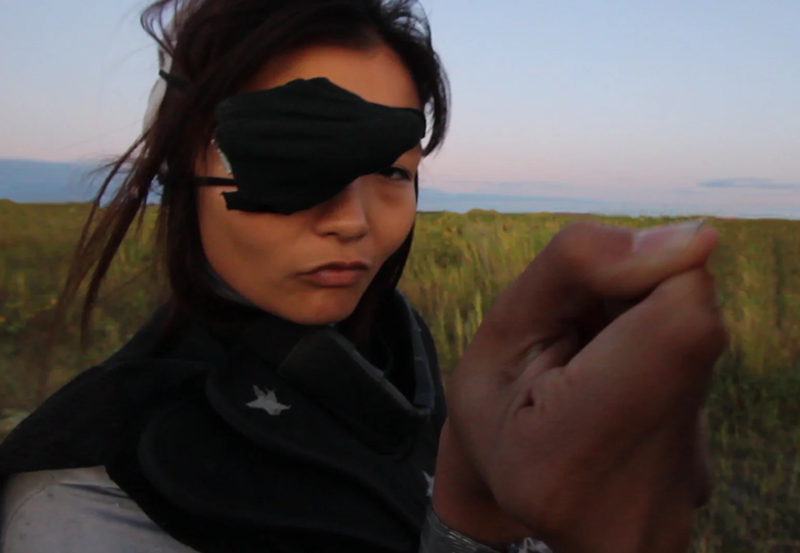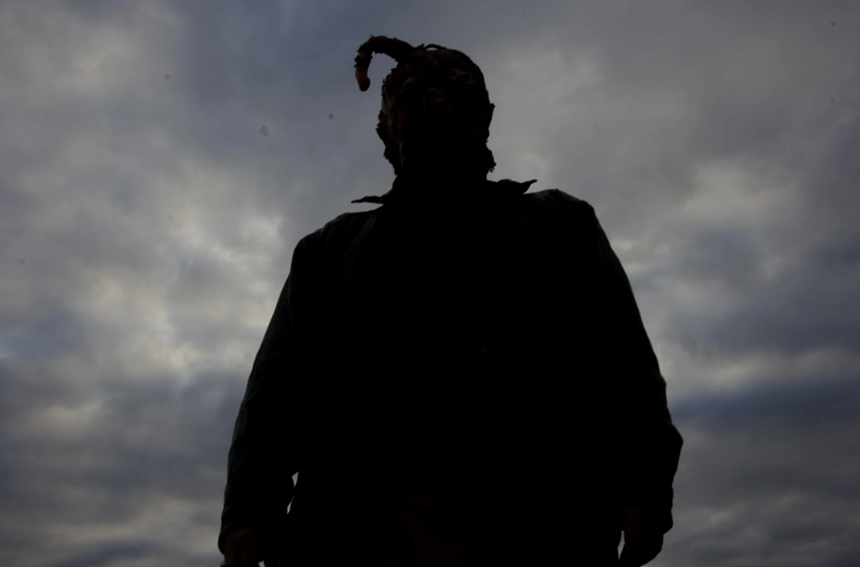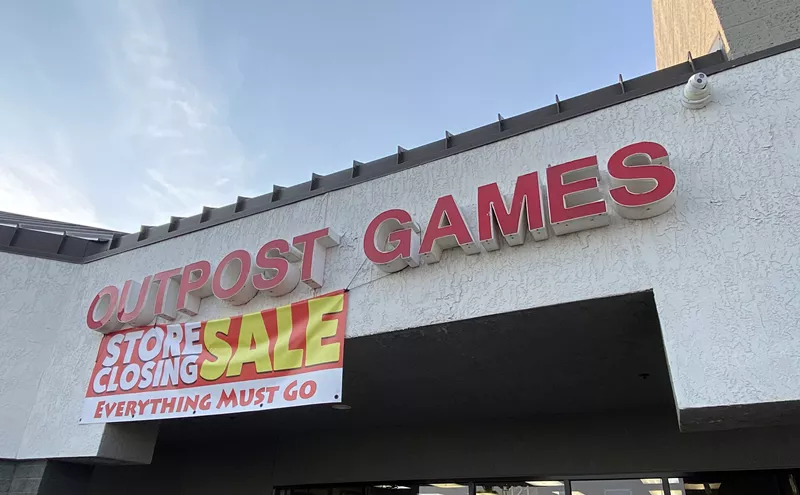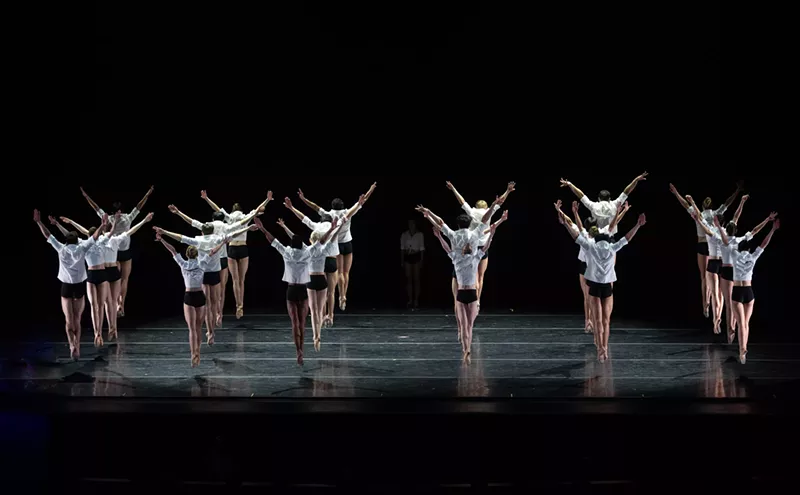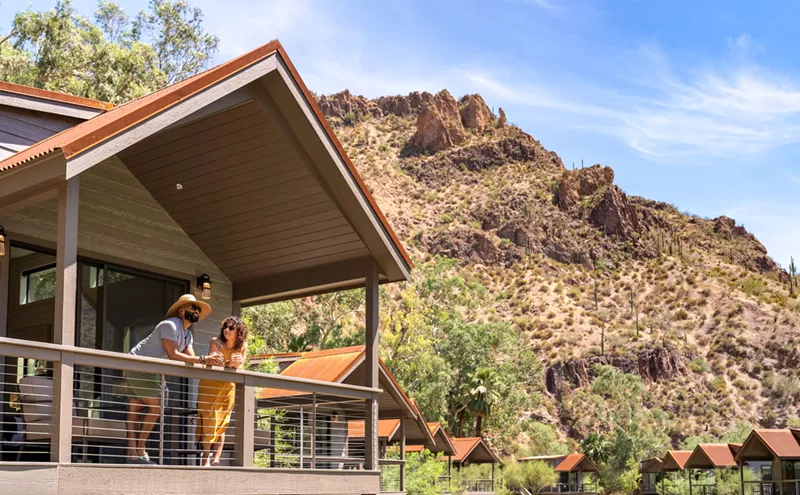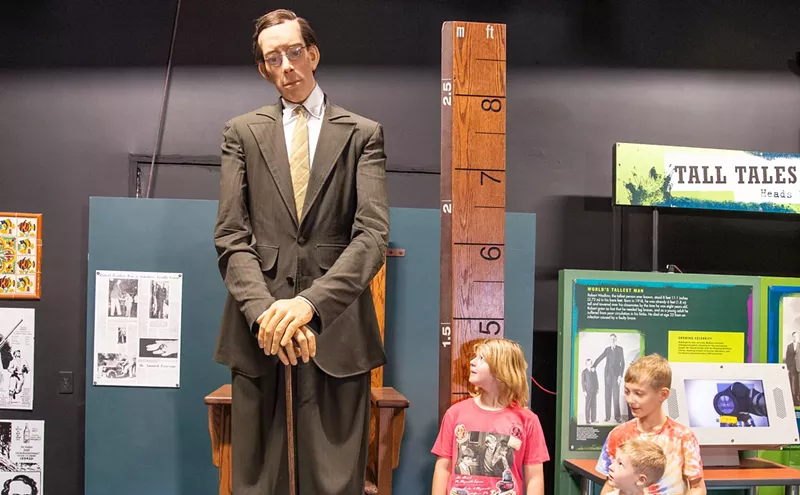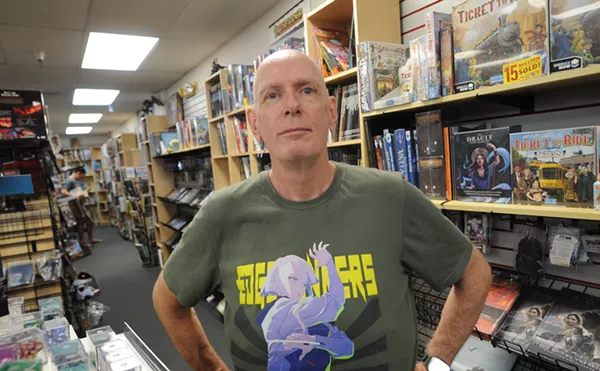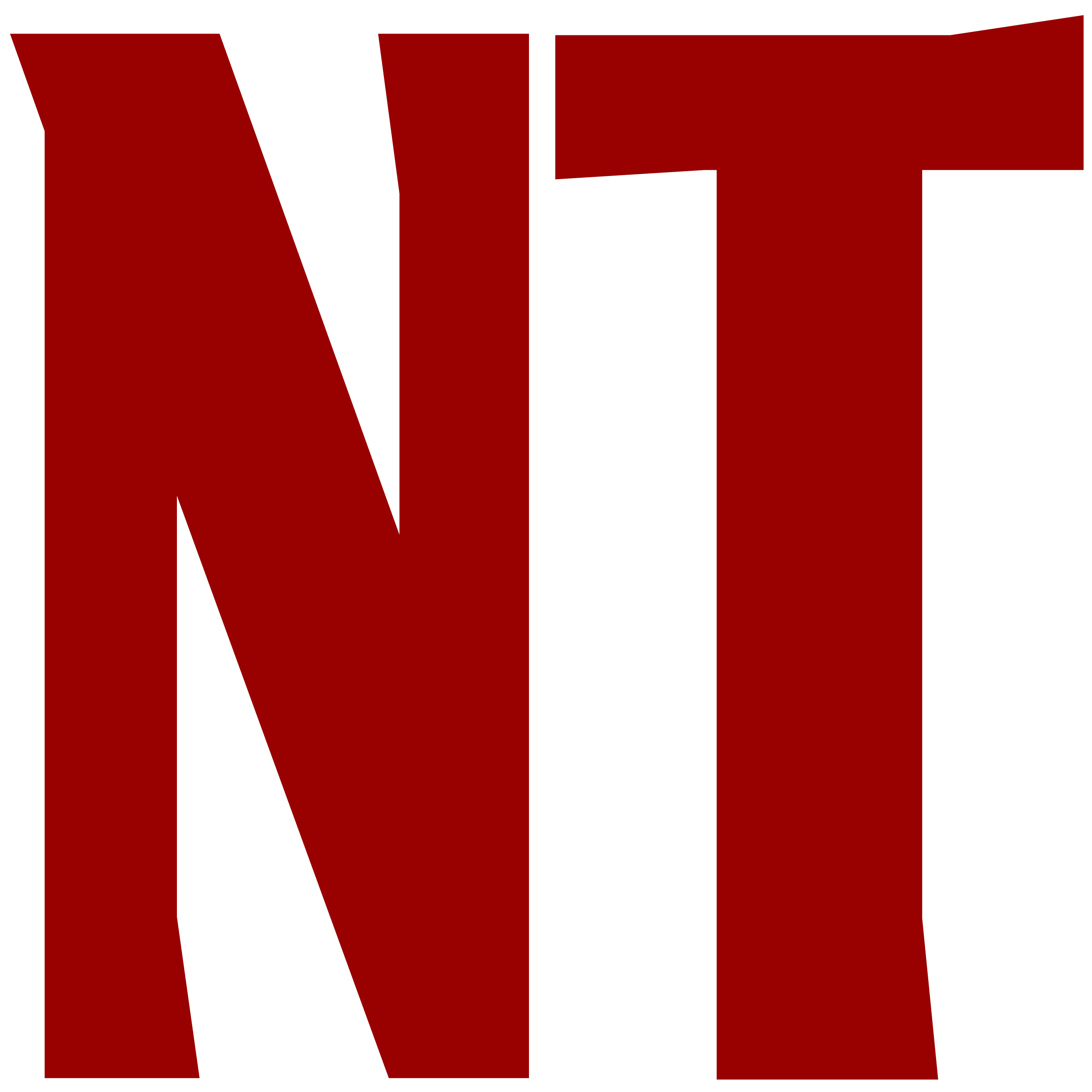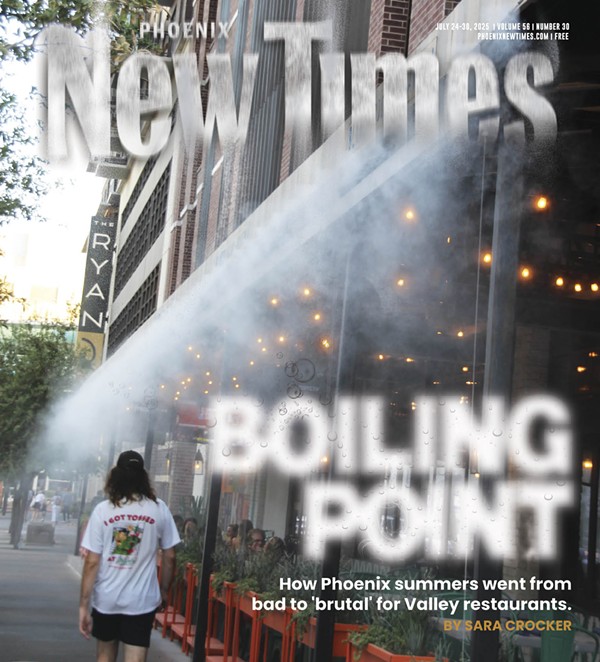Let’s play "name the movie."
Three seekers travel through a verdant field that feels otherworldly as they search for a cosmic force that can grant them their heart’s desire. If you’ve ever spent too much money buying Criterion Blu-rays, you’re probably gesticulating wildly and shouting “'Stalker"! Tarkovsky's 'Stalker'!”
It's a good guess, but you’re wrong. There’s another film that can be loosely summed up by that description: Terry Chiu’s 2022 DIY epic "Open Doom Crescendo," which will be shown in Phoenix on Tuesday, July 29.
A three-hour “ghetto cosplay convention battle royale free for all” (as one character describes their situation), "Open Doom Crescendo" takes place in an overcast Canadian field, following a sprawling cast of strange characters (which includes a man with a Lincoln hat as tall as a lamppost, a badass female warlord who fights by dancing, an asexual lisping cult leader with a boner and a monster called The Gertrude whose head looks like it was made out of irradiated hot dog meat and dildos) battling it out in the Wasteland of Angst to be the last ones standing for a chance to meet the Embodiment of Angst, a legendary figure who could free them from their suffering.
Throw "The Warriors," shonen anime, Tim & Eric, "Neon Genesis Evangelion," John Waters, martial arts films, experimental cinema, the expansive tableaus of spaghetti Westerns, shoegaze albums and every time you dressed up in cardboard armor as a kid and fought your friends in somebody’s backyard into a blender and you’d get something close to the beguiling strangeness of "Open Doom Crescendo."
Taking a cue from Hong Kong cinema, Chiu’s film features burnt-in subtitles in English and Cantonese. The subtitles serve both a practical purpose — making Chiu’s dense, philosophical and funny dialogue legible when it’s being deliberately drowned out by the film’s majestic post-rock guitar freakouts (also written and performed by Chiu) — and an aesthetic one. And while Chiu’s protagonists are often self-aware about the genre rules that bind them (talking about “power levels” and “activation windows” like "Dragonball Z" characters when they’re not ruminating about their personal shit), "Open Doom Crescendo" (to its credit) takes itself seriously.
"Open Doom Crescendo" will make its debut in Phoenix on Tuesday, when local film collective Phosphene Cinema will show the film at vintage store Overdue. The screening will also feature an exclusive recorded interview with the director that will play after the screening (before you start sweating that three-hour runtime: there is an intermission).
You won’t have to wait until the 29th to hear from Chiu, though; we got a chance to talk to the "Open Doom" auteur about subtitles, trauma in cinema and what it feels like to be watching an audience watch your movie.
Phoenix New Times: One of the things about "Open Doom Crescendo" that’s really striking is how you use subtitles in it. It’s not just the dual English and Cantonese burned-in subs; it’s how you deploy them almost like comic book sound effects. Playing with the size of the subs, doing scrolling columns of text, words that shoot across the screen like bullets … You made them a key part of the visuals. What inspired you to take this approach?
Terry Chiu: The work that I’ve done before — particularly with my first feature ("Mangoshake") — was infamous among the five people who saw it for having almost unintelligible sound. It didn’t even sound that bad to me. For some reason, the combination of it being filmed outside, being a lo-fi production and the direction of the characters — people were instructed to talk like they were having heat stroke — created this concoction of people not understanding what they were saying.
So there was this patchwork done where selected subtitles were added throughout the festival cut of "Mangoshake." I never was a fan of those because they looked like patchwork, so a way to mitigate that was to stylize them … a kind of compensation, of trying to make it seem like it was intentional even though the subtitles still looked like a consequence of bad sound or whatever.
So coming into "Open Doom," I thought that I wouldn’t have that same problem because everyone’s screaming their lines out. At the same time, we’re shooting outside again, there's barely any ADR … but I have a better understanding of how things work. But there’s all these other things like sound effects and self-sabotagingly loud music. It’s like I almost went out of the way to cancel out any advantage I would have this time.
In the early edits, I was encountering that unintelligibility issue. I didn’t want to do the patchwork thing again; it felt like it would be surrendering. Almost out of spite, I thought, "I’m just going to subtitle the whole thing, even the lines that are understandable, so you can’t pinpoint what’s hard to understand and what’s not. And I’m going to stylize it even more and make it more free form" … Then I took it to another level to tie it back to my Cantonese roots and Hong Kong films and the linguistic stylisms that I grew up with. I worked with a friend who translated it into Cantonese and subtitled it. It wasn’t a word-for-word translation; it was the essence, the equivalent. Sometimes things are even funnier in the Cantonese equivalent. So there’s a lot of Easter eggs and nuances that are in those subtitles.
What drew you to doing an outdoor shoot? It made me think of how so many martial arts and wuxia films were shot in fields and forests.
I don’t know how to do indoor lighting. I think I’ve been looking for every possible way to never have to make a movie indoors. I don’t have a single idea that’s ever felt interesting that I could set indoors. I feel like that’s what everyone does. I’ve always gravitated toward exterior storytelling … Montreal, the greater Montreal area, the suburbs, the post-urban hellscape, provides such a backdrop that I figured, well, it doesn’t seem like anyone else has been crazy enough to make a battle epic on all this.
There are so many pop culture allusions and references woven throughout "Open Doom." What do you find most compelling about the art that inspires you?
I have a lifelong affection for longform, multi-episodic storytelling, whether it’s the Star Wars hexalogy or superhero movies, comic books, genre TV, band discographies — I’ll form my own mythologies around the Linkin Park or Smashing Pumpkins discographies. The thing that inspires me the most is iconography. Storytelling that has imagery or symbolism that can have an everlasting impact on you, like Spiderman’s mask or Cyclops’ visor. Those are the things that I’m forever chasing the feeling of. ... I think the reason genre interests me is there’s a cinematic quality to it. I think they’re way more interesting than, like, people’s indie movies of good-looking people in their T-shirts looking sad and making out and then somebody dies.
I know you've attended a few "Open Doom" screenings and done Q&As afterward. How does it feel to be in the room while your movie is playing?
I get pretty stressed about the varying reactions. Sometimes the rooms are quieter, sometimes they’re louder, but my ass is usually clenched for the first hour because that first hour is the initiation hour … Classic self-sabotage, I made it the hardest hour to sit through because it’s so chaotic and abrasive. There’s this organic progression from a more experimental, no wave, hip-hop fury until, as planned, it eventually settles into these periods of more formalistic intentionality. There’s still this common visual thread that carries through it all.
It’s long, but the cool people make it to the end. I think the reward of the length of the project is that those who stick around to the end are rewarded by the (feeling of culmination), by the progression from tone to tone and style to style … Maybe people might not understand what they saw, but they felt something. Because it's supposed to be as much an experiential feeling as it can be a narrative.
Over the last decade, there’s been this storytelling trend in Hollywood films to center narratives around trauma, especially in horror. I find that "Open Doom" plays with that trauma storytelling in interesting ways. There’s no cheap catharsis; your characters aren’t ennobled or redeemed by their suffering. They just have to live with their shit. There’s no easy out for them.
That’s exactly it, man. I usually get really upset when I watch those kinds of movies because I feel like I’m being left behind as a viewer. They get to go off and live happily ever after the projector light goes out; they’re going to be OK in a way that you don’t get to be. They’re kind of like your surrogate; you go on this vicarious journey with the characters in a movie about trauma, and if the way they get through their trauma rewards them to a point that you can no longer relate to them, you can no longer feel like you’re part of them. It feels like a betrayal.
That’s how I’ve felt when watching those kinds of movies and I didn’t want to contribute to that.
After all those years of work, now that "Open Doom" is out in the world, what are you working on now? Do you have another film in the works, or are you taking time off to decompress after making your epic?
It’s hard to feel like I can take time off, not because I’m a workaholic, but because I feel the ever-present dread of everything. And the ticking clock of time itself, and feeling really anxious that, "Yeah, you’re going to be irrelevant or left behind." And wanting to continue to do stuff and knowing that you can’t do it the same way you did before because you don’t have any money left and all your past collaborators are gone…
I still want to create, I just don't know what that looks like. It’s a weird time to be trying to figure this all out ... If I’m not creating my own thing, I want to be present for other people. I feel that we have more of a responsibility than ever to show up for each other. Because at this point, art is going to be one of the last lines of defense that we have left to stick it to the evil fascists that want to take everything away that's nice and virtuous in this world.
"Open Doom Crescendo": 6 p.m. Tuesday, July 29. Phosphene Cinema at Overdue, 1346 W. Roosevelt St. Tickets are $5 at the door.

Audio By Carbonatix
[
{
"name": "GPT - Billboard - Slot Inline - Content - Labeled - No Desktop",
"component": "21251496",
"insertPoint": "2",
"requiredCountToDisplay": "2"
},{
"name": "STN Player - Float - Mobile Only ",
"component": "21327862",
"insertPoint": "2",
"requiredCountToDisplay": "2"
},{
"name": "Editor Picks",
"component": "16759093",
"insertPoint": "4",
"requiredCountToDisplay": "1"
},{
"name": "Inline Links",
"component": "17980324",
"insertPoint": "8th",
"startingPoint": 8,
"requiredCountToDisplay": "7",
"maxInsertions": 25
},{
"name": "GPT - 2x Rectangles Desktop, Tower on Mobile - Labeled",
"component": "21934225",
"insertPoint": "8th",
"startingPoint": 8,
"requiredCountToDisplay": "7",
"maxInsertions": 25
},{
"name": "Inline Links",
"component": "17980324",
"insertPoint": "8th",
"startingPoint": 12,
"requiredCountToDisplay": "11",
"maxInsertions": 25
},{
"name": "GPT - Leaderboard to Tower - Slot Auto-select - Labeled",
"component": "17012245",
"insertPoint": "8th",
"startingPoint": 12,
"requiredCountToDisplay": "11",
"maxInsertions": 25
}
]

